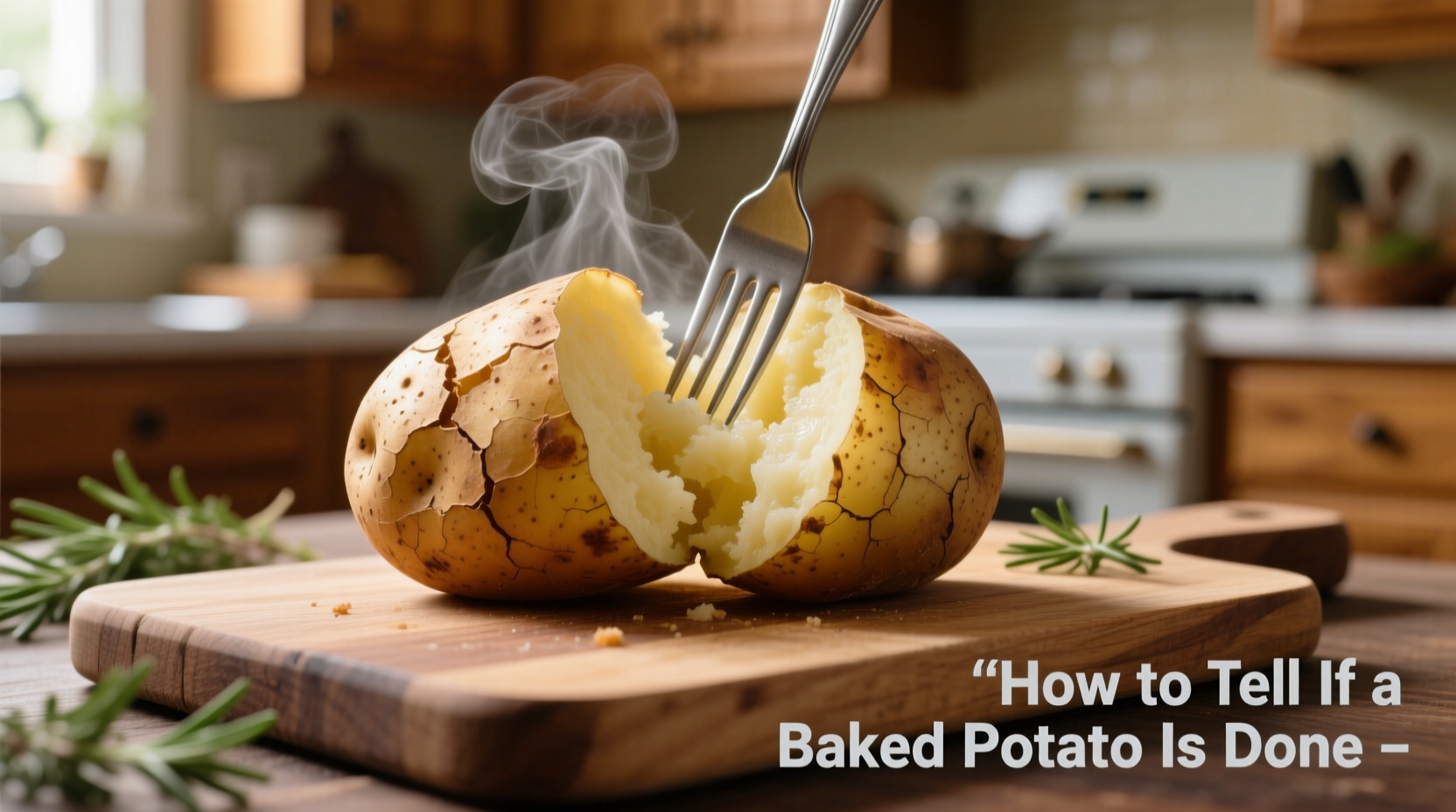Why Proper Doneness Matters for Baked Potatoes
Getting your baked potato perfectly cooked isn't just about preference—it affects both safety and eating experience. Undercooked potatoes contain resistant starch that can cause digestive discomfort, while overcooked potatoes become dry and lose their signature fluffy texture. The ideal baked potato should have fully gelatinized starch (reaching 205°F/96°C), creating that light, airy interior we all love.
The Four Most Reliable Methods to Test Baked Potato Doneness
1. The Fork Test: Your Kitchen Essential
This classic method remains popular for good reason—it's immediate and requires no special tools. When your potato is done:
- A fork or skewer should slide into the center with almost no resistance
- The utensil should encounter soft, yielding flesh rather than firm resistance
- When you twist the utensil slightly, the potato should give way easily
Pro tip: Test in multiple spots, especially if your oven has hot spots. Larger potatoes may cook unevenly, so check both ends and the middle.
2. Internal Temperature: The Most Accurate Indicator
Food science confirms that potato starch fully gelatinizes at 205°F (96°C). According to the USDA Food Safety and Inspection Service, this temperature ensures both safety and optimal texture.
| Temperature Range | Texture Result | Starch Status |
|---|---|---|
| <190°F (88°C) | Firm, undercooked | Starch not fully gelatinized |
| 190-200°F (88-93°C) | Mostly cooked, slightly dense | Partial gelatinization |
| 205°F (96°C) | Perfectly fluffy, light texture | Complete starch gelatinization |
| >210°F (99°C) | Dry, mealy texture | Over-gelatinized, moisture loss |
Insert an instant-read thermometer into the center of the potato. Wait 5-10 seconds for an accurate reading. This method eliminates guesswork, especially important for larger potatoes that may appear done externally but remain undercooked inside.
3. Visual and Tactile Indicators: Reading Your Potato's Signals
Your senses provide valuable clues about doneness:
- Skin appearance: Done potatoes develop slight wrinkling and may have small cracks
- Squeeze test: Carefully (using oven mitts!) gently squeeze the sides—it should yield slightly
- Sound test: A done potato will make a hollow sound when tapped
- Steam release: You'll notice increased steam escaping from any existing cracks

4. Time-Based Guidelines (With Important Caveats)
While timing provides a rough estimate, it's the least reliable method due to variables like:
- Potato size (a 5-ounce potato cooks much faster than a 12-ounce one)
- Oven accuracy (many home ovens vary by 25°F or more)
- Rack position (middle rack provides most even cooking)
- Starting temperature (fridge-cold vs room temperature)
As a general reference from the Culinary Institute of America:
- Medium potatoes (6-8 oz): 45-55 minutes at 400°F (204°C)
- Large potatoes (10-12 oz): 55-65 minutes at 400°F (204°C)
- Giant potatoes (14+ oz): 65-75 minutes at 400°F (204°C)
Troubleshooting Common Baked Potato Issues
What If My Potato Is Still Hard?
If your potato remains firm after the expected cooking time:
- Return it to the oven for 10-15 minute increments
- Place directly on the oven rack (not on a baking sheet) for more even heating
- Check if your oven runs cool—use an oven thermometer for accuracy
- Consider that dense varieties like Russets take longer than waxy potatoes
Rescuing an Overcooked Potato
If your potato has become dry:
- Moisten with warm milk or cream before serving
- Add a pat of butter and let it melt into the flesh
- Mix in a small amount of sour cream to restore moisture
- Next time, try wrapping larger potatoes in foil during the last 15 minutes
Pro Tips for Perfect Baked Potatoes Every Time
Professional chefs know these factors significantly impact cooking time and doneness:
- Poke holes: Prick potatoes 6-8 times with a fork to allow steam to escape, preventing bursting
- Dry skin: Rub with oil and salt for crispier skin, but skip this if you prefer softer skin
- Room temperature: Let potatoes sit out for 30 minutes before baking for more even cooking
- Oven rack position: Middle rack provides the most consistent heat distribution
- Resting time: Let potatoes rest for 5 minutes after baking—this allows residual heat to finish the cooking process
Why Some Methods Fail: Common Doneness Myths
Many home cooks rely on inaccurate indicators that lead to under or overcooked potatoes:
- The "easy piercing" myth: While a fork should slide in easily, some undercooked potatoes can be pierced if you use enough force
- Color as an indicator: Russets naturally have darker skin that doesn't change dramatically when done
- One-size-fits-all timing: A 6-ounce and 12-ounce potato need significantly different cooking times
- Assuming uniform size: Even within the same batch, potatoes vary in density and moisture content
Final Checklist for Perfect Baked Potato Doneness
Before removing your potato from the oven, verify these three critical indicators:
- Temperature: 205°F (96°C) at the center
- Texture: Fork slides in with no resistance, twists easily
- Appearance: Slightly wrinkled skin with possible small cracks
When all three conditions are met, you've achieved potato perfection—fluffy interior, flavorful skin, and just the right texture for butter and toppings to melt perfectly.











 浙公网安备
33010002000092号
浙公网安备
33010002000092号 浙B2-20120091-4
浙B2-20120091-4